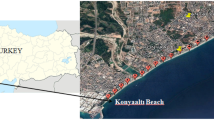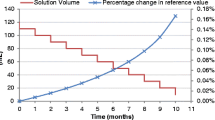Abstract
Certification of trace metals in seawater certified reference materials (CRMs) NASS-7 and CASS-6 is described. At the National Research Council Canada (NRC), column separation was performed to remove the seawater matrix prior to the determination of Cd, Cr, Cu, Fe, Pb, Mn, Mo, Ni, U, V, and Zn, whereas As was directly measured in 10-fold diluted seawater samples, and B was directly measured in 200-fold diluted seawater samples. High-resolution inductively coupled plasma mass spectrometry (HR-ICPMS) was used for elemental analyses, with double isotope dilution for the accurate determination of B, Cd, Cr, Cu, Fe, Pb, Mo, Ni, U, and Zn in seawater NASS-7 and CASS-6, and standard addition calibration for As, Co, Mn, and V. In addition, all analytes were measured using standard addition calibration with triple quadrupole (QQQ)-ICPMS to provide a second set of data at NRC. Expert laboratories worldwide were invited to contribute data to the certification of trace metals in NASS-7 and CASS-6. Various analytical methods were employed by participants including column separation, co-precipitation, and simple dilution coupled to ICPMS detection or flow injection analysis coupled to chemiluminescence detection, with use of double isotope dilution calibration, matrix matching external calibration, and standard addition calibration. Results presented in this study show that majority of laboratories have demonstrated their measurement capabilities for the accurate determination of trace metals in seawater. As a result of this comparison, certified/reference values and associated uncertainties were assigned for 14 elements in seawater CRMs NASS-7 and CASS-6, suitable for the validation of methods used for seawater analysis.




Similar content being viewed by others
References
Morel FM, Price NM. The biogeochemical cycles of trace metals in the oceans. Science. 2003;300:944–7.
Coale KH, Fitzwater SE, Gordon RM, Johnson KS, Barber RT. Control of community growth and export production by upwelled iron in the equatorial Pacific Ocean. Nature. 1996;379:621–4.
Lee JM, Boyle EA, Echegoyen-Sanz Y, Fitzsimmons JN, Zhang R, Kayser RA. Analysis of trace metals (Cu, Cd, Pb, and Fe) in seawater using single batch nitrilotriacetate resin extraction and isotope dilution inductively coupled plasma mass spectrometry. Anal Chim Acta. 2011;686:93–101.
Bruland KW, Franks RP, Knauer GA, Martin JH. Sampling and analytical methods for the determination of copper, cadmium, zinc and nickel at the nanogram per liter level in seawater. Anal Chim Acta. 1979;105:233–45.
Orians KJ, Bruland KW. The biogeochemistry of aluminum in the Pacific Ocean. Earth Planet Sci Lett. 1986;78:397–410.
Landing WM, Bruland KW. The contrasting biogeochemistry of iron and manganese in the Pacific Ocean. Geochim Cosmochim Acta. 1987;51:29–43.
Santosa SJ, Tanaka S, Yamanaka K. Sequential determination of trace metals in sea water by inductively coupled plasma mass spectrometry after electrothermal vaporization of their dithiocarmabamate complexes in methyl isobutyl ketone. Environ Monit Assess. 1997;44:515–28.
Martínez-Soto MC, Tovar-Sánchez A, Sánchez-Quiles D, Rodellas V, Garcia-Orellana J, Basterretxea G. Seasonal variation and sources of dissolved trace metals in Maó Harbour. Minorca Island Sci Total Environ. 2016;565:191–9.
Boyle EA, Sclater FR, Edmond JM. The distribution of dissolved copper in the Pacific. Earth Planet Sci Lett. 1977;37:38–54.
German CR, Elderfied H. Rare earth elements in the NW Indian Ocean. Geochim Cosmochim Acta. 1990;54:1929–40.
Wu J, Boyle EA. Low blank preconcentration technique for the determination of lead, copper, and cadmium in small-volume seawater samples by isotope dilution ICPMS. Anal Chem. 1997;69:2464–70.
Saito MA, Schneider DL. Examination of precipitation chemistry and improvements in precision using the Mg(OH)2 preconcentration ICP-MS method for high-throughput analysis of open-ocean Fe and Mn in seawater. Anal Chim Acta. 2006;565:222–33.
Wu J. Determination of picomolar iron in seawater by double Mg(OH)2 precipitation isotope dilution high-resolution ICPMS. Mar Chem. 2007;103:370–81.
Boyle EA, Handy B, Geen A. Cobalt determination in natural waters using cation exchange liquid chromatography with luminol chemiluminescence detection. Anal Chem. 1987;59:1499–503.
Willie SN, Lam JWH, Yang L, Tao G. On-line removal of Ca, Na and Mg from iminodiacetate resin for the determination of trace elements in seawater and fish otoliths by flow injection ICP-MS. Anal Chim Acta. 2001;447:143–52.
Oliveira EP, Yang L, Sturgeon RE, Santelli RE, Bezerra MA, Willie SN, et al. Determination of trace metals in high-salinity petroleum produced formation water by inductively coupled plasma mass spectrometry following on-line analyte separation/preconcentration. J Anal At Spectrom. 2011;26:578–85.
Conway TM, Rosenberg AD, Adkins JF, John SG. A new method for precise determination of iron, zinc and cadmium stable isotope ratios in seawater by double-spike mass spectrometry. Anal Chim Acta. 2013;793:44–52.
López Guerrero MM, Vereda Alonso E, Cano Pavón JM, Siles Cordero MT, García de Torres A. Simultaneous determination of chemical vapour generation forming elements (As, Bi, Sb, Se, Sn, Cd, Pt, Pd, Hg) and non-chemical vapour forming elements (Cu, Cr, Mn, Zn, Co) by ICP-OES. J. Anal. At. Spectrom. 2016;31:975–84.
Ho TY, Chien CT, Wang BN, Siriraks A. Determination of trace metals in seawater by an automated flow injection ion chromatograph pretreatment system with ICPMS. Talanta. 2010;82:1478–84.
Sohrin Y, Urushihara S, Nakatsuka S, Kono T, Higo E, Minami T, et al. Multielemental determination of GEOTRACES key trace metals in seawater by ICPMS after preconcentration using an ethylenediaminetriacetic acid chelating resin. Anal Chem. 2008;80:6267–73.
McLaren JW, Mykytiuk AP, Willie SN, Berman SS. Determination of trace metals in seawater by inductively coupled plasma mass spectrometry with preconcentration on silica-immobilized 8-hydroxyquinoline. Anal Chem. 1985;57:2907–11.
Hill S. Inductively coupled plasma spectrometry and its applications. Oxford, U. K.: Blackwell Publishing; 2007.
De Bièvre P. Isotope dilution mass spectrometry in trace element analysis in biological specimens. Herber RFM, Stoeppler M. (Eds), Elsevier, Amsterdam, 1994.
Report of the 5th Meeting of the Commité Consultatif pour la Quantité de Matière, BIPM, Paris, February 1999.
Yang L, Sturgeon RE. High accuracy and precision isotope dilution mass spectrometry: an application to the determination of Mo in seawater. J Anal At Spectrom. 2009;24:1327–35.
Houk RS. Mass spectrometry of inductively coupled plasmas. Anal Chem. 1986;58:97A–105.
Field MP, Cullen JT, Sherrell RM. Direct determination of 10 trace metals in 50 mL samples of coastal seawater using desolvating micronebulization sector field ICP-MS. J Anal At Spectrom. 1999;14:1425–31.
ISO/IEC 17025:2005(E), General requirements for the competence of testing and calibration laboratories, 2005.
International Organization for Standardization. International Vocabulary of Basic and General Terms in Metrology. 2. Geneva, Switzerland: ISO; 1993.
Meija J, Methven B, Sturgeon RE. Uncertainty of relative sensitivity factors in glow discharge mass spectrometry. Metrologia. 2017;54:796–804.
DerSimonian R, Laird N. Meta-analysis in clinical trials. Control Clin Trials. 1986;7:177–88.
Meija J, Pagliano E, Mester Z. Coordinate swapping in standard addition graphs for analytical chemistry: a simplified path for uncertainty calculation in linear and nonlinear plots. Anal Chem. 2014;86:8563–7.
Willie SN, Sturgeon RE, Berman SS. Determination of total chromium in seawater by graphite furnace atomic absorption spectrometry. Anal Chem. 1983;55:983–5.
Van Vark W, Crum S. AQ3 metals in seawater. 2015.
Cofino WP, van Stokkum IHM, Wells DE, Ariese F, Wegener JWM, Peerboom RAL. A new model for the inference of population characteristics from experimental data using uncertainties. Application to interlaboratory studies. Chemom Intell Lab Syst. 2000;53:37–55.
Glabonjat RA, Raber G, Van Mooy BAS, Francesconi KA. Arsenobetaine in seawater: depth profiles from selected sites in the North Atlantic. Environ Sci Technol. 2018;52:522–30.
Matoušek T, Currier JM, Trojánková N, Saunders RJ, Ishida MC, González-Horta C, et al. Selective hydride generation-cryotrapping-ICP-MS for arsenic speciation analysis at picogram levels: analysis of river and sea water reference materials and human bladder epithelial cells. J Anal At Spectrom. 2013;28:1456–65.
CCQM guidance note: estimation of a consensus KCRV and associated degrees of equivalence. Version 10, 2013–04-12.
Author information
Authors and Affiliations
Corresponding author
Ethics declarations
Conflict of interest
The authors declare that they have no conflict of interest.
Electronic supplementary material
ESM 1
(PDF 345 kb)
Rights and permissions
About this article
Cite this article
Yang, L., Nadeau, K., Meija, J. et al. Inter-laboratory study for the certification of trace elements in seawater certified reference materials NASS-7 and CASS-6. Anal Bioanal Chem 410, 4469–4479 (2018). https://doi.org/10.1007/s00216-018-1102-y
Received:
Revised:
Accepted:
Published:
Issue Date:
DOI: https://doi.org/10.1007/s00216-018-1102-y




